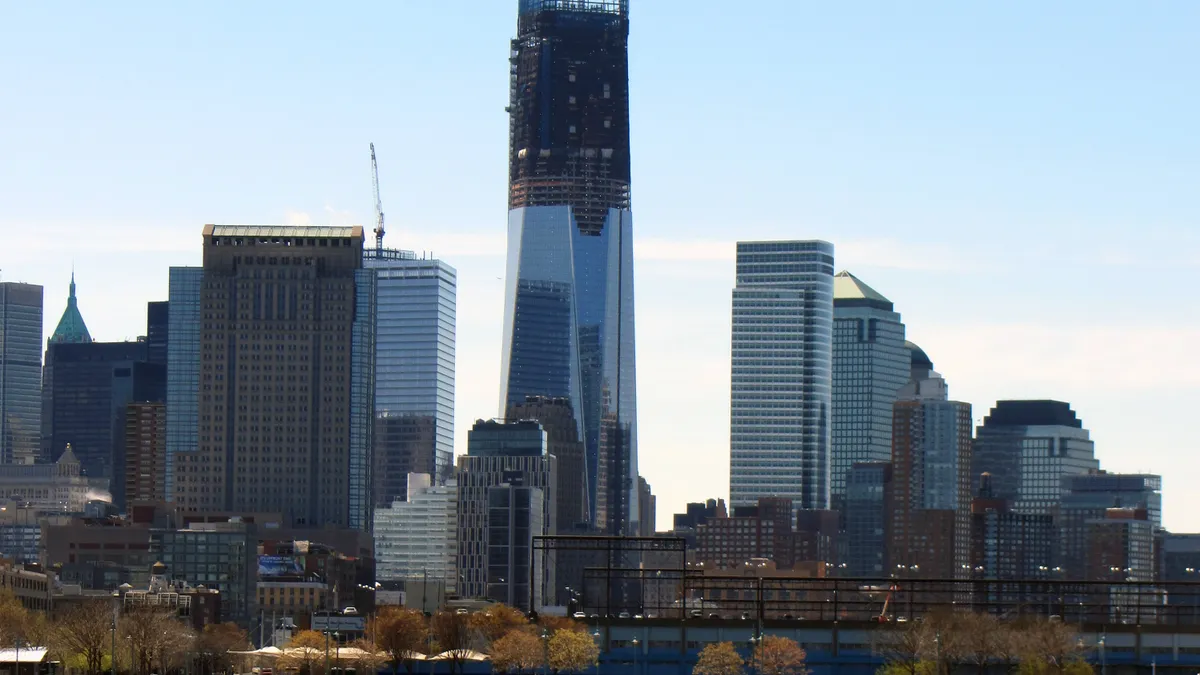[Editor's note: The following is a guest post written by Mike Freiberg, a staff writer with the site HomeDaddys.]
Since its announcement twelve years ago, One WTC (or Freedom Tower) has had several lead architects and dozens of redesigns, undergoing one transformation after another. With the installation of the spire on May 10th, the tower rises to a symbolic 1,776 feet. It isn’t the tallest or the most lavishly-appointed, but it is by far the most expensive, settling at nearly $4 billion dollars.
For comparison’s sake, the tallest building in the world—the Burj Khalifa—is over 1,000 feet taller, with a far more extravagant interior; but its construction was less than half as costly as One WTC ($1.5 billion). So what explains Freedom Tower’s monumental price tag?
It’s the first skyscraper built like a bunker
One WTC carried a heavy symbolic burden for the designers: it had to stand as a metaphor for American resilience, while also serving more pragmatically as a global financial center in the heart of New York. The architects had to show that the lessons of 9/11 would be taken seriously, without making the tower a windowless eyesore.
From outside, Freedom Tower looks like a typical, modern skyscraper—but inside, it’s built like a fortress. Installing (and more importantly, concealing) its mammoth security features was by far the greatest source of budget overruns during its seven-year construction. Here are a few of the most innovative features.
A 20-story concrete podium
To prevent a ground-level bombing like the 1993 World Trade Center attack, One WTC is set on a windowless block of concrete strong enough to withstand a 1,500 lb. truck bomb. The podium is covered in prismatic glass to conceal the blast walls, and contains nearly one million cubic feet of “iCrete”, a designer blend with three times the compressive strength of typical high-rise concrete.
A network of filters and redundant air systems
In addition to threats from outside, designers also fortified the structure against fire, airborne toxins, and biological agents, creating one of the most sophisticated ventilation systems ever built. Each stairwell is encased in a pillar of concrete, with a fully-independent, pressurized air supply so that they remain operational in an emergency. Each floor contains dozens of biological and chemical filters, as well as emergency vents than can expel dangerous elements as soon as the system detects them.
High-security elevator shafts
One WTC’s elevator shafts serve as a concrete “spine” for the building in case the steel frame collapses (as it did on 9/11). The interior walls are three feet thick, and interestingly, none of the elevators use buttons. The elevator cars instead identify each passenger, and brings them to the exact floor for which they are authorized. The building isn’t in use yet (it’s scheduled to welcome tenants this December), so it’s unclear how well this system will operate.
A colossal internal security network
The integration of all these security features is perhaps the most impressive piece of engineering in One WTC. The system connects 400 CCTV cameras, thousands of networked security doors, fully-automated elevators, and hundreds of detectors monitoring air quality and temperature. Freedom Tower’s security personnel will receive a stream of detailed status reports from every floor via a skein of heavily-shielded fiber-optic cable. The smallest details like burnt popcorn in a break room or a short in hallway lighting will reach security instantaneously.
During the first several months of operation, the security cordon will also extend to the building exterior, with DHS checkpoints and electrified fencing outside the tower—but administrators say that will only be necessary until the building becomes a normal fixture in downtown life.
As one might imagine, controversy has followed these huge security expenses. Some have called the design inappropriately paranoid, while others consider it vigilant; but in any case, these features make One WTC by far the most expensive building of its kind.
Mike Freiberg is a staff writer for HomeDaddys, a resource for stay-at-home dads, work-at-home dads, and everything in between. He's a handyman, an amateur astronomer, and a tech junkie, who loves being home with his two kids. He lives in Austin, Texas.











